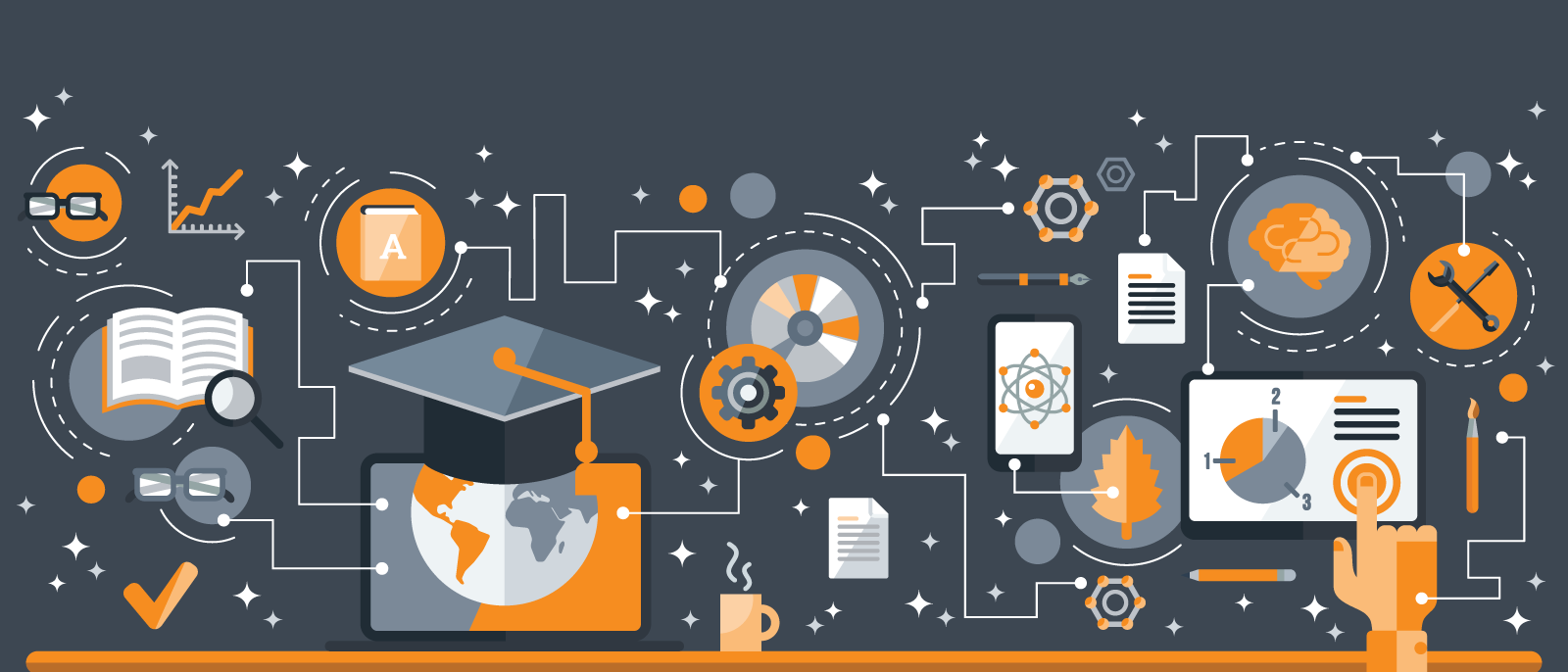
Best practices for distance learning in 2020
Lucid Content
Reading time: about 7 min
Mobile-first design. Remote work. Teleconferencing. For years, the business world has embraced tools and technologies to adapt to an increasingly connected and mobile world.
Educational institutions have adopted some of this digital transformation, too, using cutting edge tech to offer world-class education and future-thinking training. Learning management systems and online educational tools that support and supplement the work teachers are already doing are becoming increasingly common and increasingly necessary.
Here we’ll discuss some ways teachers can transition to remote or distance learning and keep students engaged without rewriting their entire curriculum.
Adjust your teaching style for distance learning
Distance learning inherently requires you to rework in-person activities—what may work in face-to-face learning may not work online. Fortunately, we’ve gathered these distance learning tips as a guide to a smooth transition to distance learning.
Design for interaction
Since children have short attention spans, distance learning comes with challenges to learner engagement, especially from home. A virtual classroom should include ample room for interaction. Interactive learning and instruction encourage students to pay attention since they are participating in a group event. Question and answer sessions, group discussions, and round-robin moments are all helpful in setting an interactive tone.
Additionally, research shows that interactive learning produces better outcomes because students retain information more quickly and more vividly. Neural connections formed over multiple robust networks produce a more synthetic comprehension—like the difference between having a conversation with an old friend versus listening to them tell a long-winded story.
Focus on active learning
Don't just be interactive with your students—engage them in active learning in your virtual classroom. Putting principles into practice is a great way to keep students plugged into the educational journey and to see the value in the current lesson in context.
For example, if teaching the Pythagorean theorem, an active learning instructor would have each student locate a tape measure in their house and measure the length of the hypotenuse or diagonal of the room the student is in. If a student is studying the periodic table of elements, have them go through cereal boxes to identify any chemical names from the periodic table in the nutrition information. If teaching civics, you can have students look up the website of local elected officials, call the office of those officials, and report back on what they learned from the exchange.
Your students are full of energy and curiosity—use it to your (and their) advantage.
Chunk your lessons
Distance learning means your online classroom is also unfairly competing with distractions from home. To keep attention, do your best to avoid long-winded lectures. Instead, focus your online classroom on chunks or specific parts of a lesson plan to engage students.
Why do we chunk? Because shorter lessons and lectures make it easy for students to browse through content and consume more if they need to.
Embrace technology
Technology should help, not hinder, the teaching and learning process. Many teachers wonder how to increase student success in the online classroom and complain about the effect that technology, specifically cell phones, has on the learning environment. What better time to experiment with a tech-ready modus operandi for how to create a virtual classroom?
If the battle over cell phones is hard-fought in the classroom, then you're not going to have much better luck when students are home—but use this to your advantage. Distance learning opens up the opportunity to adopt and implement a broader range of tech tools.
Consider experimenting with some of these tech tools in your online classroom.
Lucidchart
For individual assignments, your students need to keep their tasks and processes organized. Visual workspaces like Lucidchart give students the ability to draw out thought maps, project plans, courses of action, and beyond, all from a secure, collaborative, and industry-leading web platform. Lucidchart also offers custom templates that allow teachers to distribute, gather, and grade assignments. Teachers can even encourage remote teamwork with Lucidchart’s advanced collaboration tools like chat, comments, and color-coded brainstorming sessions.
Slack
For group assignments, your students will need to communicate with each other—maybe it's time to introduce them to Slack, the industry leader in team communication. Using professional-grade communication tools is a great way to offer students a compelling education in addition to post-school professional development. Plus, how fun would it be to tell one of your class clowns to "pick up the Slack"?
Canvas
Online instruction has progressed by leaps and bounds in recent years thanks to digital infrastructure like Canvas. In addition to their paid plans, this online learning management system provides a free open-access platform for 2-4 year colleges, K-12 schools, nonprofit organizations with a public service or education focus, and government agencies with an education focus.
Educators who use Canvas appreciate the functionality of its adaptable cloud technology and its robust learning management system. Canvas even provides free access to all site data, making research a snap for education professionals.
Implement regular assessments and readiness checks
When big changes are afoot, time meets its match. Deadlines are especially difficult amidst widespread change, from large-scale digital adoption to distance learning. Implementing regular assessments will have several positive impacts on your digital classroom.
First, students who receive regular assessments will have greater self-awareness and an improved ability to assess themselves and their comfort over time. Second, they'll have a strong propensity toward high performance—"He who knows better does better."
One way to perform assessments is by engaging exit tickets: have students show you their work or explain a key concept at the end of a lesson before letting them leave, and use that information to assess the student’s mastery level and what type of support they still need.
Further, assessments help instructors keep curricula relevant by offering qualitative feedback on lesson plan efficacy. Readiness checks keep classrooms prepared and ahead of the curve for any potential emergency.
Regularly check in with students and make sure they're learning. For example, call on your students throughout a lesson—not just at the end. Create some quick ways for students to respond. Have students hold up a finger if they agree, two fingers if they disagree. Check-in periodically to make sure students still understand the experience or story, ask for someone to summarize the central point of the lesson or anecdote, and open up the group occasionally for questions or discussion. Be sure to check for slumping body language, acting out, or distraction. Just like in the classroom, body language doesn’t lie.
And don’t stop at learning check-ins. Take time to do emotional wellness check-ins, too. Ask your students how they are feeling and if there’s anything they want to talk about. Build a “How Am I Feeling?” chart and pull it up at the beginning and end of your classroom sessions. Instruct students to grab their photos from the left side and drag them over to the emoji on the right side that best matches their current feelings.
Allowing students to participate in this kind of visual emotional wellness check-in makes it easier for students to communicate their feelings even if they can’t quite articulate them verbally. Students who might otherwise feel too shy to talk openly about their feelings will be more willing to share during this type of class exercise.
Reach out to other teachers
People bond over shared identity and shared experiences. You don't live in a vacuum, nor have you ever wanted to. You are not alone and other teachers have faced similar challenges. Have you tried every possible solution, or are you just one step away from breaking through? Are you doing the right thing(s)? Or are you still working through your adjustments to education?
All of these questions and more can be answered simply by being in community with other teachers. That means that not only are there resources available to you, but that you can be a powerful resource in return. Reach out and teach out!
Be brave, and just do it!
You will make mistakes, and that's ok! Transitions don't have to be perfect. And your students are always more forgiving than you realize, more admiring than you notice, and more thankful than they know how to express. At the very least, your class provides a sense of normalcy and structure.
While distance learning comes with its own unique challenges, there’s a wealth of resources to help you thrive during the transition. Distance learning can be fun, engaging, collaborative, and imaginative—it all depends on how you wield the available tools. Powerful things happen when pedagogy meets technology.

Learn how to use Lucidchart to optimize distance learning.
Learn moreAbout Lucidchart
Lucidchart, a cloud-based intelligent diagramming application, is a core component of Lucid Software's Visual Collaboration Suite. This intuitive, cloud-based solution empowers teams to collaborate in real-time to build flowcharts, mockups, UML diagrams, customer journey maps, and more. Lucidchart propels teams forward to build the future faster. Lucid is proud to serve top businesses around the world, including customers such as Google, GE, and NBC Universal, and 99% of the Fortune 500. Lucid partners with industry leaders, including Google, Atlassian, and Microsoft. Since its founding, Lucid has received numerous awards for its products, business, and workplace culture. For more information, visit lucidchart.com.


